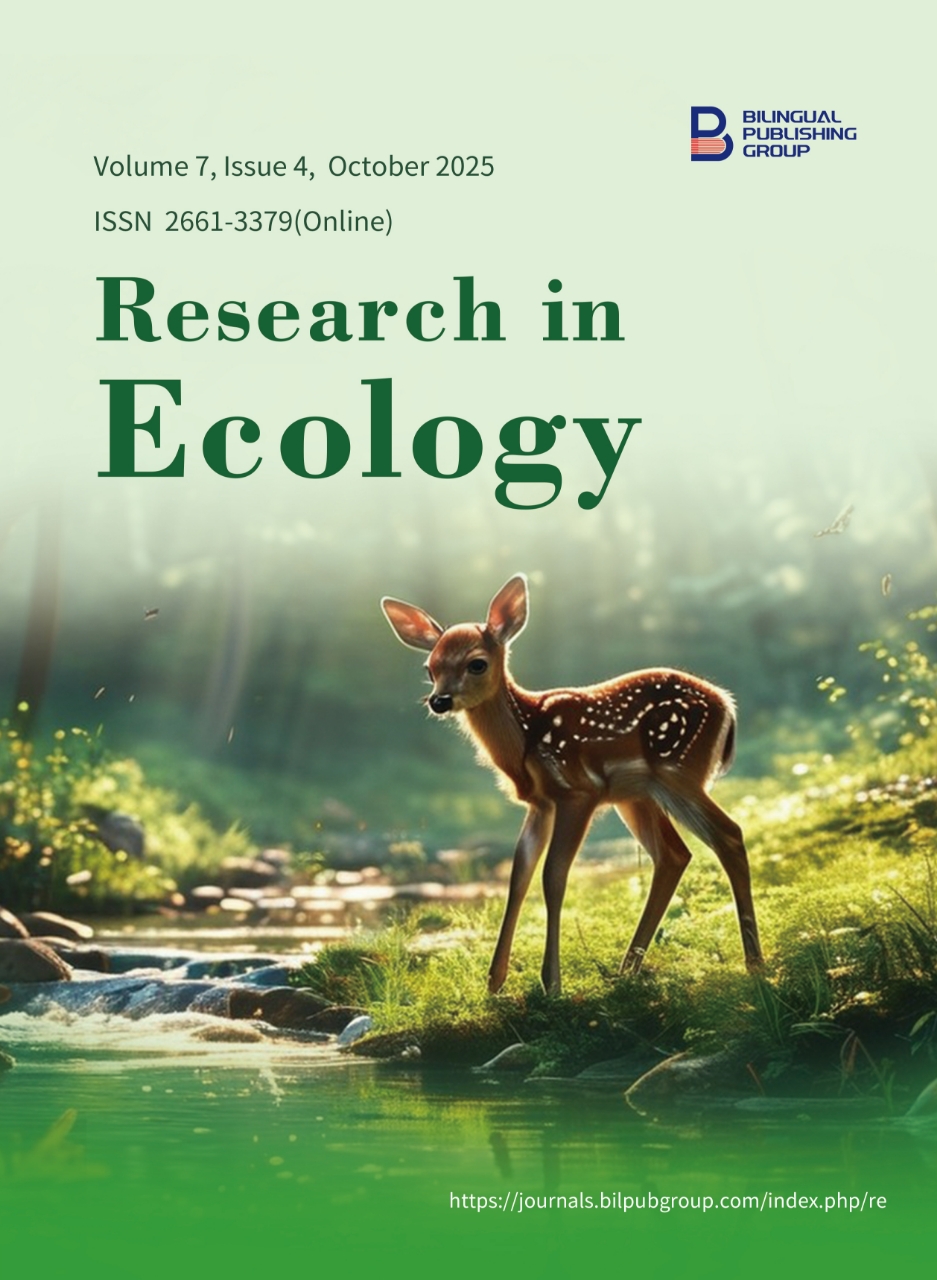
Javan Slow Loris Population and Ecology at a New Site: Mendolo Forest, Central Java, Indonesia
DOI:
https://doi.org/10.30564/re.v7i4.9801Abstract
The Javan slow loris (Nycticebus javanicus) is a primate endemic to Java Island, Indonesia. Its conservation status has been categorized by IUCN as Critically Endangered, and it is included in Appendix I of CITES. Current population status and distribution remain unrecorded. The research was conducted in Mendolo Forest, Pekalongan Regency, Central Java Province, Indonesia, to estimate population size and distribution patterns. Data collection occurred September 15–19, 2024, using line transect methodology with spotlighting and GPS mapping. The transect locations are in each hamlet of Mendolo Village, namely Sawahan Hamlet with two transects, Mendolo Kulon Hamlet with four transects, Mendolo Wetan Hamlet with two transects, and Krandegan Hamlet with one transect. Data collection on javan slow loris in Mendolo Forest began at 7:30 p.m. to 12 a.m. We identified 8 individuals exhibiting semi-solitary behavior. Javan slow loris in Mendolo Forest are distributed across 3 hamlets, with 3 individuals in Sawahan Hamlet, 4 individuals in Mendolo Kulon Hamlet, and 1 individual in Krandegan Hamlet. The population density of Javan slow loris in Mendolo Forest is 18.35 individuals/km², with the highest density found in Krandegan Hamlet at 33.3 individuals/km² and the lowest in Mendolo Wetan Hamlet at 0 individuals/km². The estimated population of Javan slow loris in Mendolo Forest is 21.9 individuals. These findings provide crucial baseline data for conservation management of Javan slow loris populations in Java.
Keywords:
Distribution; Nocturnal; Nycticebus javanicus; PrimateReferences
[1] Semiadi, G., Phadmacanty, N.L.P.R., Maharadatunkamsi, D., et al., 2020. Conservation Status and Role of Mammals on Java Island. LIPI Press: Jakarta, Indonesia. pp. 1–258. Available from: https://www.researchgate.net/publication/348841007_STATUS_KONSERVASI_MAMALIA_P_JAWA (in Indonesian)
[2] Roos, C., Boonratana, R., Supriatna, J., et al., 2014. An updated taxonomy and conservation status review of Asian primates. Asian Primates Journal. 4(1), 2–38.
[3] Supriatna, J., 2022. Field Guide to the Primates of Indonesia. Springer International Publishing: Cham, Switzerland. pp. 1–233. DOI: https://doi.org/10.1007/978-3-030-83206-3
[4] Sianturi, E., Master, J., Umar, S., et al., 2023. Behavior of Sumatran Slow Rock (Nycticebus Coucang) In PLN Electricity Networks on Two Types of Electricity Network Security in Air Naningan District, Tanggamus, Lampung Province. Indonesian Journal of Biotechnology and Biodiversity. 7(3), 112–118. DOI: https://doi.org/10.47007/ijobb.v7i3.207
[5] Groves, C., Maryanto, I., 2008. Craniometry of slow lorises (genus Nycticebus) of insular Southeast Asia. In Primates of the Oriental night. LIPI Press: Jakarta, Indonesia. pp. 115–122.
[6] Nekaris, K.A.I., Jaffe, S., 2007. Unexpected diversity of slow lorises (Nycticebus spp.) within the Javan pet trade: implications for slow loris taxonomy. Contributions to Zoology. 76(3), 187–196. DOI: https://doi.org/10.1163/18759866-07603004
[7] Nekaris, K.A.I., Munds, R., 2010. Using facial markings to unmask diversity: the slow lorises (Primates: Lorisidae: Nycticebus spp.) of Indonesia. In: Gursky, S., Supriatna, J. (eds.). Indonesian primates. Springer: New York, NY, USA. pp. 383–396. DOI: https://doi.org/10.1007/978-1-4419-1560-3_22
[8] Roos, C., 2003. Molecular Phylogeny of Prosimians, Slender Monkeys, and Gibbons [PhD thesis]. München University: München, Germany. (in German)
[9] Okayama, T., Kurniati, H., 2006. Genetic diversity of slow loris (Nycticebus coucang) based on mitochondrial DNA. Tropics. 15(4), 377–381. DOI: https://doi.org/10.3759/tropics.15.377
[10] Grow, N.B., Nekaris, K.A.I., 2015. Does toxic defence in Nycticebus spp. relate to ectoparasites? The lethal effects of slow loris venom on arthropods. Toxicon. 95, 1–5. DOI: https://doi.org/10.1016/j.toxicon.2014.12.005
[11] Rode-Margono, E.J., Nijman, V., Wirdateti, W., et al., 2014. Ethology of the critically endangered Javan slow loris Nycticebus javanicus E. Geoffroy Saint-Hilaire in West Java. Asian Primates. 4(2), 27–38.
[12] Moore, R.S., Cabana, F., Nekaris, K.A.I., 2015. Factors influencing stereotypic behaviours of animals rescued from Asian animal markets: A slow loris case study. Applied Animal Behaviour Science. 166, 131–136. DOI: https://doi.org/10.1016/j.applanim.2015.02.014
[13] Thorn, J.S., Nijman, V., Smith, D., et al., 2009. Ecological niche modelling as a technique for assessing threats and setting conservation priorities for Asian slow lorises (Primates: Nycticebus). Diversity and distributions. 15(2), 289–298. DOI: https://doi.org/10.1111/j.1472-4642.2008.00535.x
[14] Sodik, M., Pudyatmoko, S., Yuwono, P.S.H., et al., 2020. Better providers of habitat for Javan slow loris (Nycticebus javanicus E. Geoffroy 1812): A species distribution modeling approach in Central Java, Indonesia. Biodiversitas Journal of Biological Diversity. 21(5), 1890–1900. DOI: https://doi.org/10.13057/biodiv/d210515
[15] Wirdateti, S., 2006. Habitat and Trade Survey of Nycticebus coucang and Tarsius in Palembang and Prabumulih South Sumatra. LIPI: Bogor, Indonesia. (in Indonesian)
[16] Wirdateti, H.D., 2008. Distribution and habitat of slow loris (Nycticebus coucang javanicusy) in community forests and plantations of Ciamis Regency, West Java. Laporan Teknik Puslit Biologi-L1PI. 2008, 1425–1433. (in Indonesian)
[17] Maolani, A., Khairina, W., Suryanda, A., 2021. The Influence of Human Activities on the Distribution of the Javan Slow Loris (Nycticebus Javanicus) in the Kemuning Forest, Temanggung Regency. Biologi Edukasi: Jurnal Ilmiah Pendidikan Biologi. 13(1), 1–5. (in Indonesian)
[18] Nekaris, K.A.I., Nijman, V., 2007. CITES proposal highlights rarity of Asian nocturnal primates (Lorisidae: Nycticebus). Folia Primatologica. 78(4), 211. DOI: https://doi.org/10.1159/000102316
[19] Latae, A., Monde, A., Hasanah, U., 2019. Carbon Reserves in Three Types of Land Use in Tudua Village, Bungku Tengah Subdistrict, Morowali Regency. Agrotekbis: Jurnal Ilmu Pertanian (e-journal). 7(3), 293–298. Available from: http://jurnal.faperta.untad.ac.id/index.php/agrotekbis/article/view/428 (in Indonesian)
[20] Setiawan, A., Nugroho, T.S., Wibisono, Y., et al., 2012. Population density and distribution of Javan gibbon (Hylobates moloch) in Central Java, Indonesia. Biodiversitas Journal of Biological Diversity. 13(1), 23–27. DOI: https://doi.org/10.13057/biodiv/d130105
[21] Bismark, M., 2011. Standard Operating Procedure (SOP) for Species Diversity in Conservation Areas. Balitbang Kehutanan: Bogor, Indonesia. pp. 1–40.
[22] Iswandaaru, D., Setiawan, A., Winarno, G., 2018. Wildlife Management Practical Guide. Universitas Lampung: Bandar Lampung, Indonesia. pp. 1–56. Available from: http://repository.lppm.unila.ac.id/7723/1/PANDUAN PRAKTIKUM MHL.pdf (in Indonesian)
[23] Rodliyya, Z.R., 2021. Distribution of the Javan Slow Loris (Nycticebus javanicus) in the Masigit Kareumbi Hunting Park Area. Wanamukti: Jurnal Penelitian Kehutanan. 24(2), 92–101.
[24] Pambudi, J.A.A., 2008. Population, Behavior, and Ecology Study of the Javan Slow Loris (Nycticebus javanicus E.Geoffroy, 1982) in the Bodogol Forest of Mount Gede Pangrango National Park [Master's thesis]. Indonesia University: Depok, Indonesia. Available from: https://lib.ui.ac.id/detail?id=20235832&lokasi=lokal
[25] Winarti, I., 2011. Habitat, Population, and Distribution of Javan Slow Loris (Nycticebus javanicus Geoffroy 1812) at Talun in Tasikmalaya and Ciamis [Master's thesis]. Bogor Agricultural Institute: Bogor, Indonesia. (in Indonesian)
[26] Subcommittee on Conservation of Natural Populations, 1981. Techniques for the Study of Primate Population Ecology. National Academy Press: Washington, D.C., USA. DOI: https://doi.org/10.17226/18646
[27] Romdhoni, H., Komala, R., Sigaud, M., et al., 2018. Feeding study of the Javan Slow Loris (Nycticebus javanicus Goeffroy, 1812) in Talun, Cipaganti Village, Garut, West Java. Al-Kauniyah. 11(1), 9–15. DOI: http://dx.doi.org/10.15408/kauniyah.v11i1.4914 (in Indonesian)
[28] Fitch-Snyder, H., Schulze, H., Larson, L.C., 2001. Management of Lorises in captivity: a husbandry manual for Asian Lorisines (Nycticebus & Loris ssp.). Center for Reproduction of Endangered Species-Zoological Society of San Diego: San Diego, CA, USA.
[29] Wiens, F., 2002. Behavior and ecology of wild slow lorises (Nycticebus coucang): social organization, infant care system, and diet [PhD thesis]. Bayreuth University: Bayreuth, Germany.
[30] Sari, D.F., Imron, M.A., 2020. The utilization of trees by endangered primate species Javan slow loris (Nycticebus javanicus) in shade-grown coffee agroforestry of Central Java. IOP Conference Series: Earth and Environmental Science. 449(1), 012044. DOI: https://doi.org/10.1088/1755-1315/449/1/012044
[31] Widiana, A., Sulaeman, S., Kinasih, I., 2013. Population and Distribution Study of the Javan Slow Loris (Nycticebus Javanicus, E. Geoffroy, 1812) in Talun, Sindulang Village, Cimanggung District, Sumedang, West Java. JURNAL ISTEK. 7(1), 33–52. Available from: https://journal.uinsgd.ac.id/index.php/istek/article/view/245
[32] Starr, C., Nekaris, K.A.I., Leung, L., 2012. Hiding from the moonlight: luminosity and temperature affect activity of Asian nocturnal primates in a highly seasonal forest. PloS one. 7(4), e36396. DOI: https://doi.org/10.1371/journal.pone.0036396
[33] Rahayu, G.D.A.K.D., Analysis of community local wisdom in protecting water resources. Jurnal Teknologi Lingkungan Lahan Basah. 6(1), 61–70. DOI: https://doi.org/10.26418/jtllb.v6i1.25700 (in Indonesian)
[34] Nekaris, K.A.I., Blackham, G.V., Nijman, V., 2008. Conservation implications of low encounter rates of five nocturnal primate species (Nycticebus spp.) in Asia. Biodiversity and conservation. 17, 733–747. DOI: https://doi.org/10.1007/s10531-007-9308-x
[35] Sholihah, A., Conservation strategy of Javan slow loris Nycticebus javanicus by Geoffroy, 1812 in Java Island [Bachelor's thesis. UIN Syarif Hidayatullah Jakarta: Jakarta, Indonesia. (in Indonesian)
[36] Purwanto, A., Rosyidin, H., 2019. Distribution And Abundance Of Javanese Slow Moon (Nyticebus javanicus) In Mount Tampomas Nature Tourism Park. Wanamukti: Jurnal Penelitian Kehutanan. 22(2), 73–81. DOI: http://dx.doi.org/10.35138/wanamukti.v22i1I.331 (in Indonesian)
[37] Arismayanti, E., Perwitasari, R.D., Winarti, I., 2018. The home range and spatial use of the javan slow loris (Nycticebus javanicus) in Gunung Halimun Salak National Park, West Java. Jurnal Sumberdaya Hayati. 4(2), 28–41. DOI: https://doi.org/10.29244/jsdh.4.2.28-41 (in Indonesian)
[38] Wirdateti, W., 2012. Distribution and Habitat of Javan Low Loris (Nycticebus Javanicus) in Vegetables Gardens at Mount Papandayan, Garut District Area. Berita Biologi. 11(1), 65694.
[39] Romdhoni, H., 2021. Daily activity and home range of Javan slow loris (Nycticebus javanicus) in Cipaganti Village, Garut Regency, West Java [PhD thesis]. IPB University: Bogor, Indonesia. Available from: http://repository.ipb.ac.id/handle/123456789/108700
[40] Rowe, N., 1996. The pictorial guide to the living primates. Pogonias Press: East Hampton, NY, USA.
[41] Withaningsih, S., Parikesit, P., Ayundari, A., et al., 2018. Distribution and habitat of Javan slow loris (Nycticebus javanicus É. Geoffroy, 1812) in non-conservation area. AIP Conference Proceedings. 2019(1), 060006. DOI: https://doi.org/10.1063/1.5061915
[42] Reinhardt, K.D., Nekaris, K., 2016. Climate-mediated activity of the Javan Slow Loris, Nycticebus javanicus. AIMS Environmental Science. 3(2), 249–260. DOI: https://doi.org/10.3934/environsci.2016.2.249
[43] Wirdateti, H.D., Sumadijaya, A., 2011. Distribution and habitat of the Javan slow loris (Nycticebus javanicus) in agricultural land (community forest) in Lebak District (Banten) and Mount Salak (West Java). Jurnal Zoo Indonesia. 20(1), 17–25. Available from: https://www.academia.edu/83103436/Sebaran_Dan_Habitat_Kukang_Jawa_Nycticebusjavanicus_DI_Lahan_Pertanian_Hutan_Rakyat_Wilayah_Kabupaten_Lebak_Banten_Dan_Gunung_Salak_Jawa_Barat
Downloads
How to Cite
Issue
Article Type
License
Copyright © 2025 Muhammad Yoga Saputra, Ike Nurjuita Nayasilana, Galuh Masyithoh, Arif Setiawan

This is an open access article under the Creative Commons Attribution-NonCommercial 4.0 International (CC BY-NC 4.0) License.




 Muhammad Yoga Saputra
Muhammad Yoga Saputra






